June 19th, 2012
| 5 Comments »
I’ve been on a mostly plant-based eating plan for just over a year now and have no intention of ever going back to eating meat on a regular basis. I’m not against having a bit of it here and there if the mood suits me, but with a heightened awareness of how it deeply affected my health, I’m off of the stuff for the long term.
Trouble is, I’ve been searching for cooking inspiration and while I can find a great deal online in the blogs that I follow, I hadn’t come across a really good source until I serendipitously found Michael Natkin’s blog, Herbivoracious, and within a day’s time was invited to a local book signing with the author. Everyone who attended the event received a complimentary cookbook and several tantalizing bites from the simple and gorgeous recipes in the book.
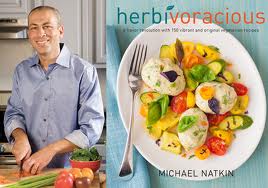
I haven’t devoured a cookbook like this in a very long time. I’ve purchased a few promising vegetarian cookbooks through used book stores, but have come away from them feeling uninspired, or worse, dismayed at the boring recipes. In our current state of food, with a wealth of ingredients available to us, fresh produce everywhere and home cooks hitting up the internet with abandon to share their stories and recipes, we shouldn’t feel like pasta and vegetables make up the bulk of a vegetarians meals, but that was the message a lot of vegetarian cookbooks still seem to send. I wanted something that reflected the modern cuisine, full of a wide selection of fresh ingredients, unique spices, terrific grains and a grown-up mentality towards consumption of plant-based foods. Just a few pages in to Michael’s book and I knew I’d found what I was looking for, breathing an excited sigh of relief. I immediately started marking pages, rich with inspiration, my mouth already watering over what was to come.
One aspect of this book that I love is that it mirrors my own cooking philosophy, in that a recipe should be a guide, and not a cut and dried interpretation of the finished dish. Michael clearly discusses ways to change up his recipes, suggesting additional ingredients or substitutions and encouraging the reader to utilize what’s on hand. Every dish is simple, yet elegant, running the whole range of time needed for completing the recipes from about 10 minutes to pull together an easy salad to longer, in-depth recipes for those special occasions. The book is full of advice on sourcing ingredients, caring for your knives, planning your meals and making your prep easier to manage; he covers so many little details that it makes the book more than just a cookbook, but something akin to treasured kitchen advice. The cover page is gorgeous, but if it gets torn, stained or otherwise in your exploration, the actual cover itself still has it’s beautiful logo. I like that in a book.
Even while still at the book signing event, chatting excitedly with a few friends and paging through the book, I came across the Golden Beet Tartare recipe and knew that would be tops on my list. I adore gold beets and it sounded like a delicious summery salad for a hot, sticky day.
I wasn’t wrong at all about that. The heat is on, Minnesota. It’s time to stay cool, right?

Fresh and bright, this simple salad has crunch and texture galore, the rich earthy taste of beets and mellow cucumber and onion. The original recipe called for raw red onion which I don’t ever use as I dislike raw allium in anything, so I substituted grilled vidalia onions with just enough snap remaining. Once it was all pulled together I thought it still needed a bit more color to jazz up the visual aspect, so I finely chopped some kale leaves that gave it the perfect balance.
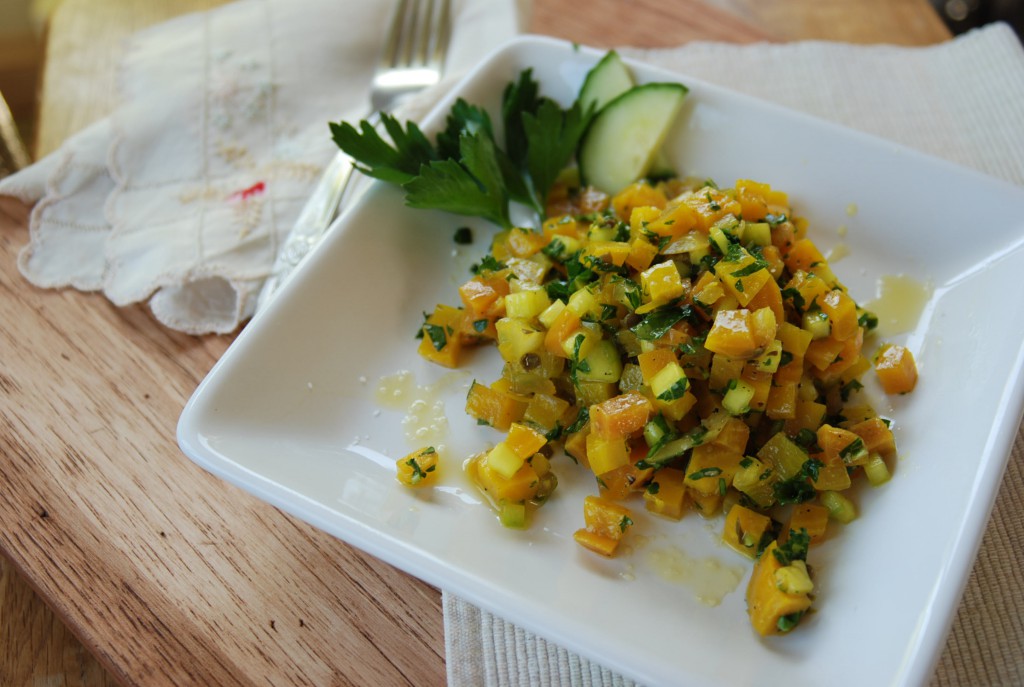
I can foresee this recipe becoming a regular in my kitchen, giving it repeated appearances and endangering my endless love of beets. With the upcoming beet season looming, and such pretty colors and patterns in this nutritious and healthy root vegetable, I vow to practice enough restraint to keep it fresh and desirable so we can continue to enjoy it’s benefits. Right now, I’m fighting off the urge to consume the entire container of this salad. A definite winner.
Please visit Michael’s site, for his complete recipe for Golden Beet Tartare. I’m going to give you my method, which, as Michael encourages, is my own take on the recipe.
Golden Beet Salad
3 medium beets, tops trimmed (save them and eat them if it’s your thing)
1/2 an English Cucumber, peeled and finely diced
1/2 medium Vidalia onion, grilled but still somewhat crunchy, finely diced
1 T. capers, drained and minced
1/2 c. kale leaves, finely minced
3 T. olive oil
1 t. fresh lemon zest
1 T. fresh squeezed lemon juice
1 T. fresh chives, minced
2 T. fresh parsley, minced (I used flat leaf; curly would work just as well)
Sea salt and fresh ground black pepper
Heat oven to 400°. Place a square of foil in an 8×8 baking pan and put beets in the foil. Drizzle with a bit of olive oil and fold the foil over the beets. Roast the beets until a knife inserted in them slips out easily. The time will depend on the size of your beets, but plan for at least 45 minutes to an hour. Allow the beets to cool, then peel and dice them.
In a bowl, add the beets, cucumber, onion, capers, kale, lemon zest and juice, chives and parsley. Drizzle in the oil, add a few shakes of sea salt and grinds of pepper. Stir to combine and taste for seasoning. Allowing the salad to sit for a few hours, or overnight before serving will deepen the flavors. Adjust seasonings before serving.
DISCLAIMER:
I received a complimentary copy of Herbivoracious from attending the book signing event.
All opinions and feedback about the book are strictly my own.
June 13th, 2012
| 4 Comments »
Summer is all about the simple, right? There’s such an abundance that planning a meal becomes moot, and your food comes together easily with a few ingredients, a nice olive oil to drizzle, maybe even served on a paper plate so that we can get back outside. Back to summer and enjoyment.
I’ve been on a creative kick with fruit, as evidenced by that gorgeous and frightfully easy Strawberry Balsamic Vinaigrette, and when blueberries went on sale at a local grocer, I stockpiled them, dropping them on yogurt, in cereal, atop pancakes and just about any other vehicle to my mouth that one can imagine. Nothing like fresh blueberries.
And there is nothing quite like this Blueberry Compote, resplendent with Lemon Thyme and fresh lemon juice.
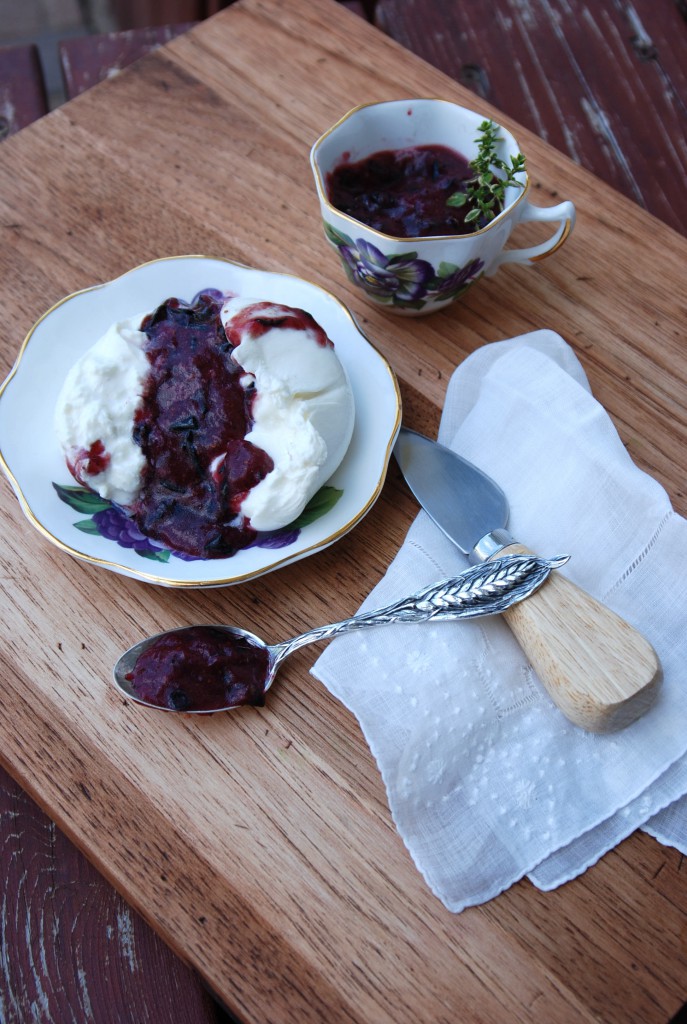
Coupled with a fast and furious love for the cheese within a cheese known as Burrata, and an ongoing affair with the tender and tiny striped leaves of the Lemon Thyme plant, I took a leap of faith on the perfect marriage of lemon and blueberry and created this quick topping that complimented the creamy cheese to utter perfection.
On a hot day, breaking open a ball of fresh mozzarella, watching the dreamy interior slip in to the bowl, mixing with the dark, deep blue of the berries, this was a quintessential summer treat. It’s made to cool down the sultriest of days. It doesn’t require much else than a spoon, really. Or good toasted bread, because really, anything tastes good on toast, doesn’t it?? And toast is a much easier means to achieving a good meal than any other base as it goes well with just about anything placed on top of it. I think a good loaf of cinnamon bread would be ideal for this creamy, berry-filled treat.
Aren’t familiar with Burrata? It’s a ball of fresh mozzarella that’s filled with shreds of MORE fresh mozzarella that’s soaked in rich cream. It’s cheese, and then some and every bit of it is rich and satisfying. It’s a nice appetizer, a perfect salad option (think good grilled veggies awash in that phenomenal cheese bath) or a delightful dessert. At upscale grocers, you should be able to find it with the other fresh mozzarella products in the deli.
All that’s left to desire is a warm, lazy day and the need to fill the belly.
Blueberry Compote with Lemon Thyme
1/2 c. fresh blueberries, washed.
2 T. fresh lemon thyme, minced
1 t. fresh lemon zest
1-2 t. fresh squeezed lemon juice
Pinch of good sea salt and fresh ground black pepper
2-3 T. good quality olive oil (use the best you’ve got here)
Mash berries in a glass measuring cup and stir in the lemon thyme, lemon zest and juice. Allow to stand for a while in order to blend the flavors. Whisk in the oil, add salt and pepper to taste, and more lemon if you wish. Chill thoroughly. The mixture will thicken as it cools, due to the oil. Whisk it again before serving to loosen.
In a bowl, carefully place one Burrata and using a spoon, break it open down the center, allowing the creamy middle to spread out. Spoon the chilled compote over the Burrata, drizzle a little oil over it and a thin pinch of good sea salt. Grab a spoon.
June 4th, 2012
| 7 Comments »
It’s almost ridiculous how simple and delicious this vinaigrette is, how a few smashed berries and a drop or two of balsamic vinegar can transform into a delightful, light and spring-like marinade for the freshest of fresh greens, but this is the very reason why we blog, share and shout our discoveries. These delicious surprises need to be more widely known.

Do you ever feel like the very fiber of your body fills up sometimes with the grimy bits of your life? Sucking you down and drawing all the energy out of you? I’m very blessed with an easy job that’s only {barely} part-time, but it’s a whacky schedule that leaves only a few days a week completely free and I often cram them with activity with friends, or cooking, household needs, market trips, etc… so much that there comes a time when my body just wants to scream “WAIT! Will you SLOW down a minute???” My sweet husband sees this on my face much clearer than I ever feel it in my bones, and gently urges me to listen. I love that man. So Memorial Weekend came, I had a whopping FIVE DAYS OFF and our lake home called, and finally, I listened. Complete with said husband’s urging me to “Just go.” And within the walls of a beloved summer home, rich with memory and the ability to lull me to a state of relaxation that releases all those icky, grimy bits, the creative mind floods with possibility.
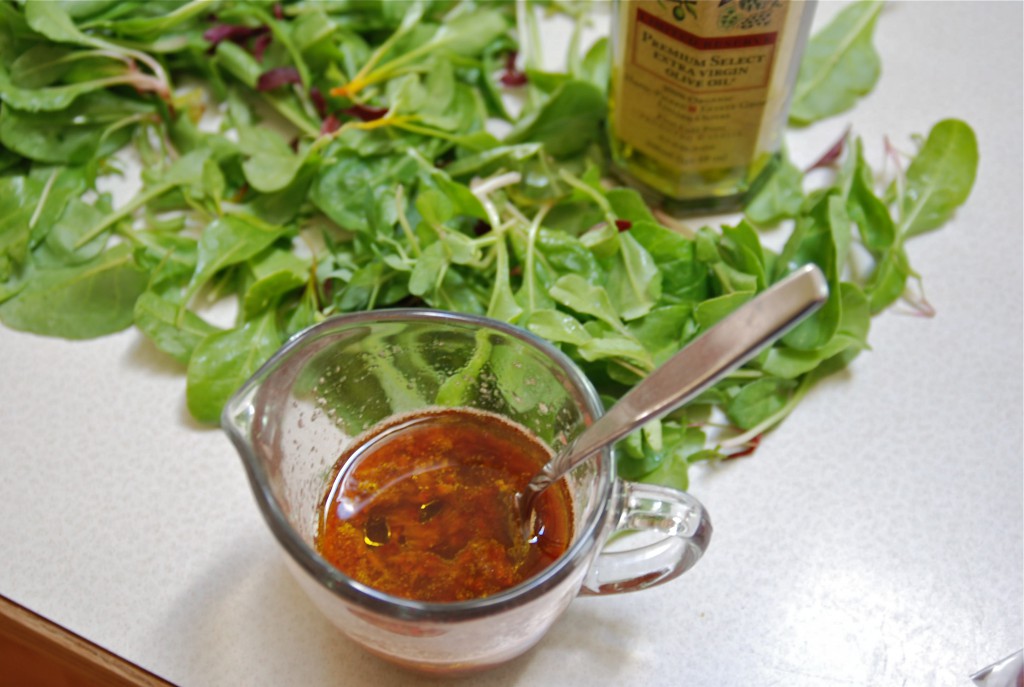
Prior to my escape, and ahead of a pending thunderstorm, I browsed the insanely crowded St. Paul Farmers Market and packed a large sack of fresh greens to take along with me. Thunderous clouds chased me home, and by the time I pulled the greens out to clean them, the sky had opened, lightning flashed and thunder rolled and the cat climbed in a cupboard to hide, poor thing.
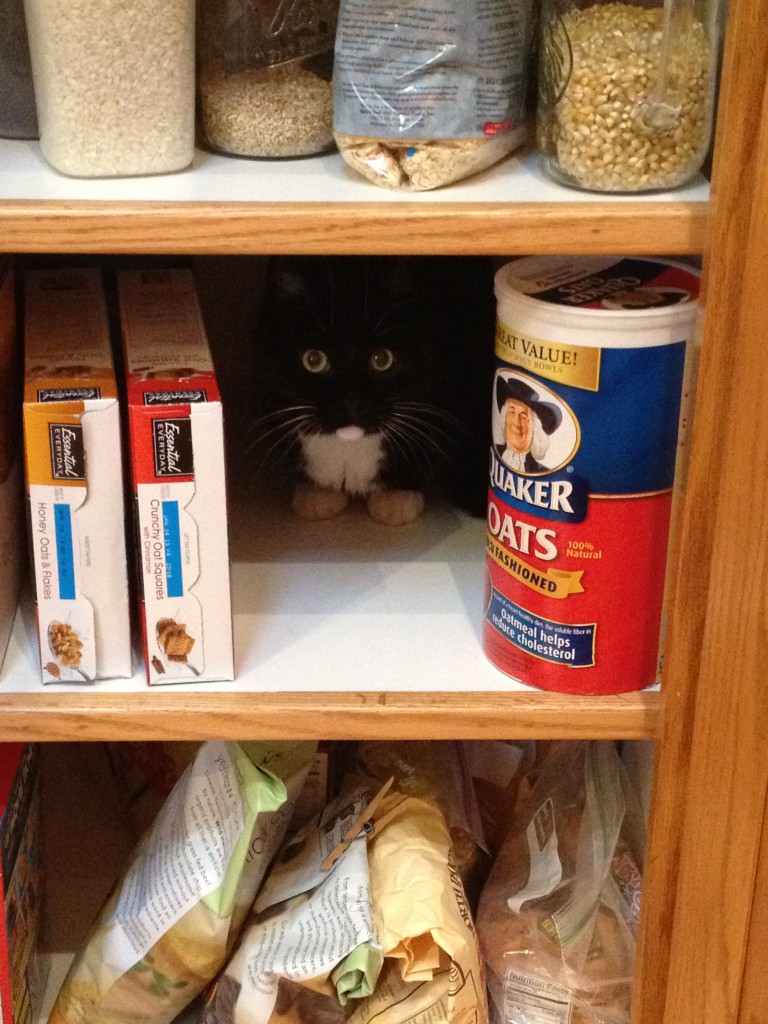
{{mr. big eyes}}
I certainly don’t blame him. Thunder does that to a soul, sometimes.
And away from the city, with the sparkling lake outside and lush humid air circulating, I opened the bag of freshly washed pea shoots I’d purchased, a bunch so enormously large that my two hands could not span the circumference and they thoughtfully conveyed “We need something more than what comes in a bottle.” and with the pack of strawberries saying ‘Hey! What about me?’ I spurred a breakthrough. What? Your food doesn’t speak to you? Shame. There’s is a lot to hear from our food these days.
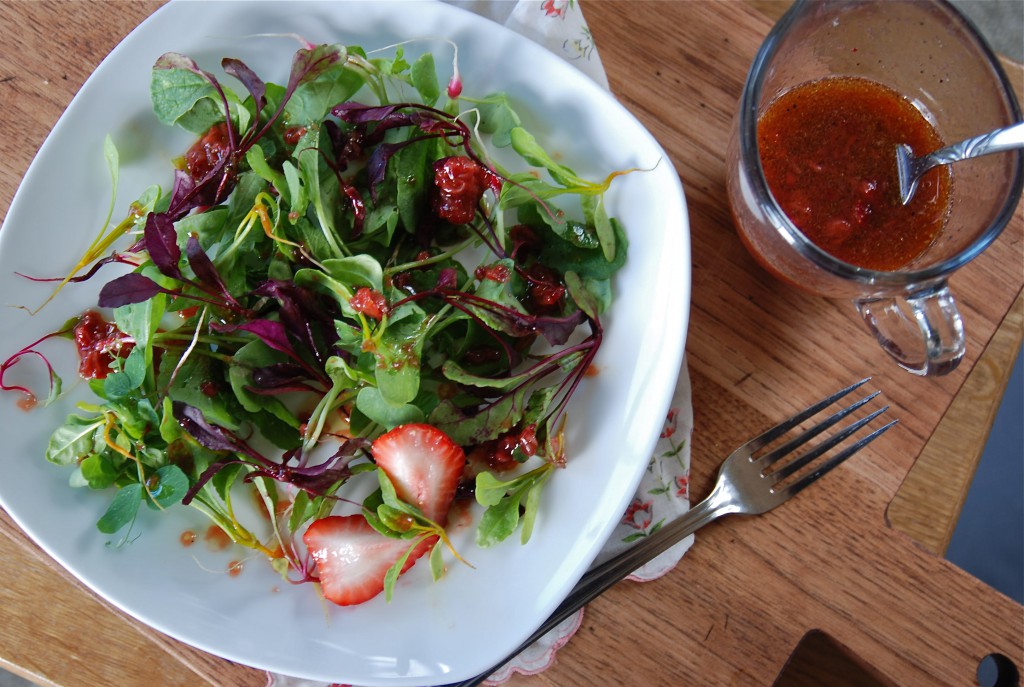
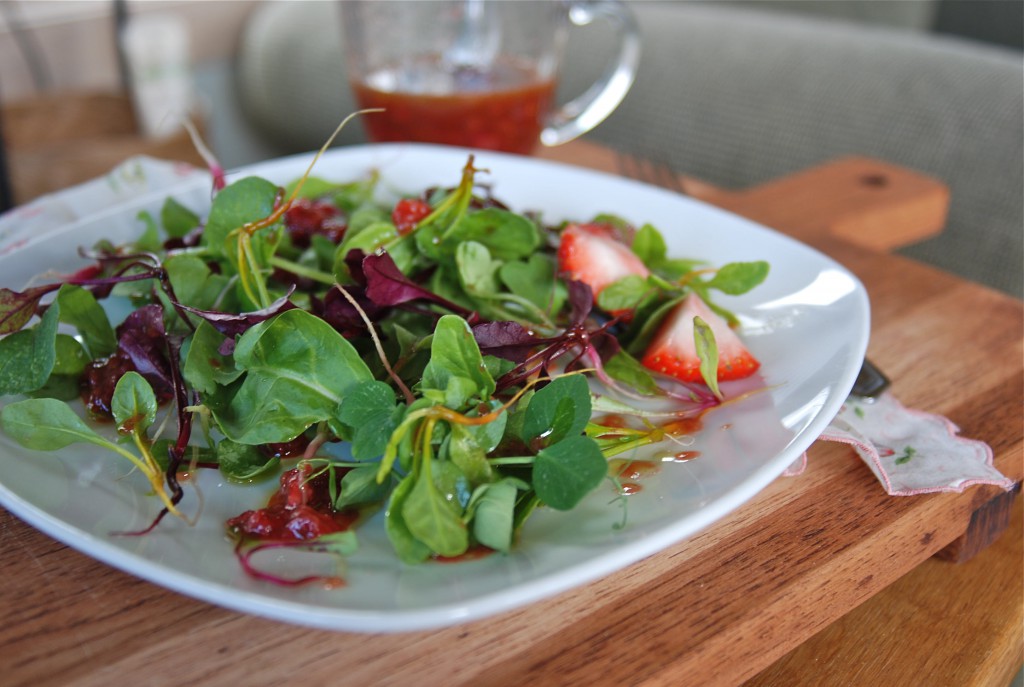
And if pea shoots haven’t yet been discovered in your eating repertoire – and mercy, do you like peas? try the pea shoots, you will not regret it!- microgreens of any kind are a perfect option, as well as the freshest of spring lettuces, spinach, chard, kale….. the possibilities choke with potential, all dancing about, trying to show us the best they can offer. And if you’re privy to a garden with teeny root vegetable greens that require thinning, like radish or beets, those little shoots that you pull from the ground are delicious too. We thinned baby lettuce and radish from the lake garden, then the beets at home were thinned and the bag of greens that resulted nearly made me weep with joy. Silly, I know. But that abundance is sweet manna, no greater thing to a hungry soul drawn tight from the grimy bits of life.
This kind of salad, where freshness is bursting from every corner of the plate is where you would happily pull out your very best bottle of olive oil to use in this vinaigrette. You can’t imagine the taste of that plate up there; I was so enamored of it myself and I’m the impetus behind it, but when the first bite slipped between my lips, coating them with sweet-tart strawberry, dressed in perfect olive oil, I wondered if this truly was heaven on earth, bound in a plate of über-local garden greens and a super simple vinaigrette. I ate it for breakfast, it was that good.
Strawberry Balsamic Vinaigrette
This “recipe”, so to speak, isn’t precise with measurements. And I apologize to those who require those parameters. Do your best with these suggestions.
1 pint of strawberries, washed and hulled
Balsamic vinegar
Good quality olive oil
Brown sugar
Sea salt and fresh ground pepper
Salad greens of the proper quantity for the number of people you’re serving.
As you wash your berries, keep an eye out for the inevitably softer, slightly mushy berries. Set these aside, as their sharper, wine-y taste make them perfect for your vinaigrette.
Wash and spin dry your greens.
In a small measuring cup, place 3-6 chopped berries (dependent on how much vinaigrette you wish to make) and mash them with a fork to release their juice. Add a few drops of balsamic vinegar and a generous pinch of brown sugar. Stir it together and leave it on the counter. How long? My first batch sat for nearly three hours. The second, only about 15 minutes. Mash the berries on occasion, and stir to keep it emulsified.
Just before serving your salad, add the olive oil. How much you add depends on how many berries make up the base. More berries? More oil. Add less than you think at first, as you can always pour in a bit more. You want a nice balance of sweet berry, tart balsamic and smooth oil. Shake a few more drops of balsamic as needed, add a dash of salt and pepper and taste everything along the way. You’ll know when it’s perfect.
Plate the greens, add a few sliced berries and drizzle the vinaigrette over the top. I like to keep the chunks of mashed fruit in there, but if you’re a purist, strain it before using. But those chunks are delicious.
May 10th, 2012
| 16 Comments »
There are plenty of food items, when given a second chance (ok, and sometimes a third or fourth) will reveal much more to your palate than they did on the initial try. Every time I hear of someone disliking a specific food, I ask them how many times they’ve eaten it, how it was prepared or where they had it or any number of questions to determine what they don’t like about it. I always want to know the whys and hows and whats of someone’s intense aversion to a certain food.
When I first met Mike, he told me he did not like salmon. Not one bit. When pressed for more information, he revealed that when he’d eaten it, it was tough in texture (definitely overcooked) and tasted fishy (definitely not very fresh) and so I made him a salmon dinner one night of a terrific piece of fresh salmon that was perfectly cooked. I hooked him for life, pun intended. A poorly prepared food item can be a real turn off. For the longest time as a kid, I absolutely hated pork due to it being overcooked and tough as nails. Once I tasted the beauty of perfectly cooked pork, tender and succulent, I was reformed.
A lot of times, if it isn’t the way it’s cooked then it’s the texture. This was true of my tastes for a very long time. And almost all of the foods that I once disliked as a child, and even in to adulthood have now made themselves a permanent space in my life. Foods such as tomato, onion, squash of all kinds, eggplant, mushrooms…. this list is all about texture. And my initial introduction to Buckwheat groats, also known as Kasha, turned me off due to the texture as well. But the second glance, with a better cooking method in hand and some quick innovation in the kitchen, I turned this healthy grain into a mind-blowing salad that I can’t wait to make again.
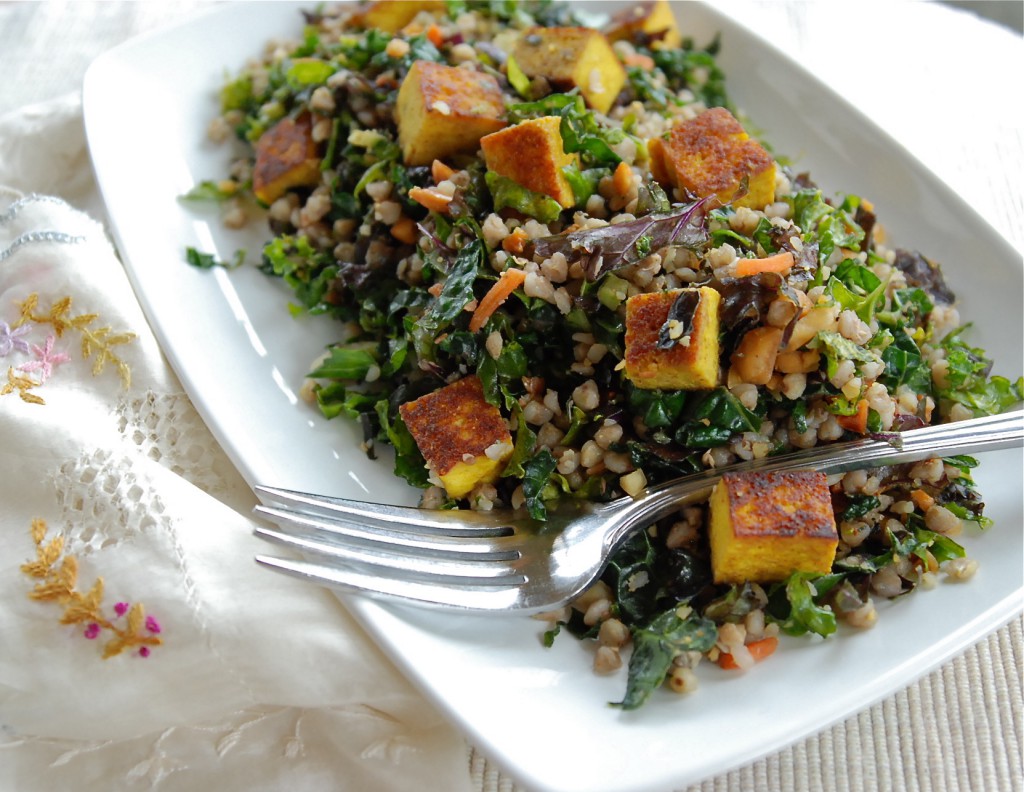
As a singular food item, I’m still not enthralled with kasha, but I think that alone, this grain is pretty uninspiring. That all changes when mixed together with others, kind of like that quiet and unassuming person who comes alive in the right crowd. Kasha grains are tiny, heart-shaped and solid, similar to barley grains, with a sweet, nutty flavor and a nice chewy texture. Buckwheat groats are a potent nutritional item, with no cholesterol, sodium or saturated fat. It’s high in fiber and magnesium, with a low glycemic index. Mixed with shredded kale, dressed lightly in a simple oil & vinegar dressing and dusted with sea salt and cracked pepper, the grains added a perfect complement to kale’s crunchy personality. Chunks of tofu, seared crisp after a curry bath marinade, made for eye-catching color and a protein boost.
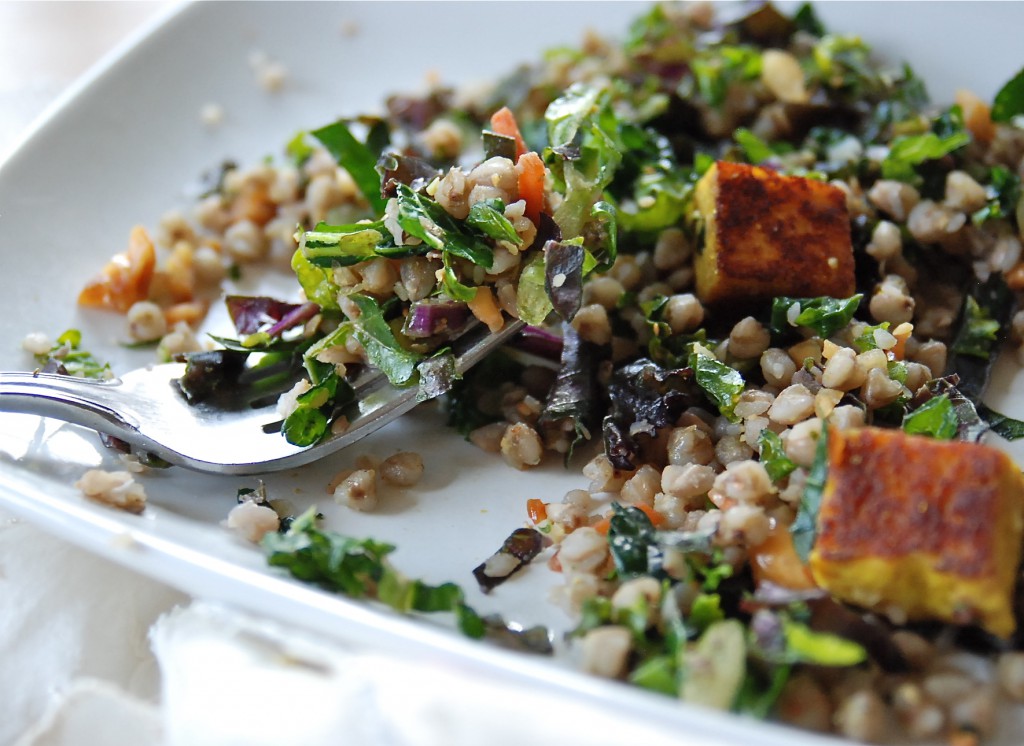
I was a little concerned that this salad would be a bit light, lacking the substance needed to fuel a body’s needs through the day, or evening, but after consuming a small plate of it, I was surprisingly full, and that satiation lasted until bedtime, and beyond. A small portion for lunch the next day easily carried me through the remainder of work too.
And speaking of second chances……
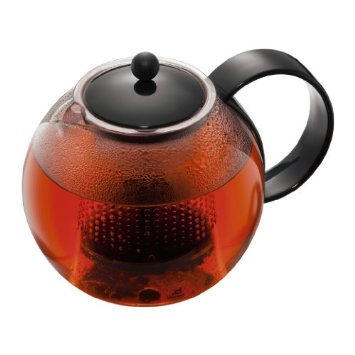 This delightful 4-cup Bodum Assam Teapot needs a new home. Do you love tea? I drink a lot of tea, and have a somewhat shocking collection of it in a cupboard. I also have a smaller Bodum Teapot that doesn’t get used as much as I would like. So this one could be yours, all for the sake of a comment. Tell me what kind of tea you like to drink, hot or cold or whatever, and you’ll have a chance. I will pick one name on Sunday May 13th. This delightful 4-cup Bodum Assam Teapot needs a new home. Do you love tea? I drink a lot of tea, and have a somewhat shocking collection of it in a cupboard. I also have a smaller Bodum Teapot that doesn’t get used as much as I would like. So this one could be yours, all for the sake of a comment. Tell me what kind of tea you like to drink, hot or cold or whatever, and you’ll have a chance. I will pick one name on Sunday May 13th.
And now, how about that recipe??
Kasha with Kale and Curried Tofu
1 pkg extra firm tofu, drained and cut in to cubes
2 T. curry powder
1/4 c. olive oil
1 c. raw buckwheat groats (available at co-ops)
2 c. water
Sea salt and fresh cracked pepper
1 pkg Cut N Clean Greens Rainbow Kale Salad (with or without the dressing- which can be used in lieu of a vinaigrette)
About a half cup of your favorite vinaigrette recipe, or similar bottled version
Crushed peanuts, optional (but a delicious and crunchy addition)
In a small skillet, begin toasting the buckwheat groats over medium-low heat. Have the water ready in a separate lidded pan. As the buckwheat begins to heat up and you start to smell a nice nutty scent, start the water heating. Continue toasting the buckwheat, shaking the pan to avoid scorching, while the water heats up. When the water begins boiling, carefully start shaking the toasted groats in to the water. They will sizzle and the water will steam up as you add the groats, so don’t dump them all at once, just a small amount at a time. Once they are all in the boiling water, reduce the heat to a bare simmer, cover the pan and cook the groats for about 15 minutes. The water should be completely absorbed and the top of the groats will look dry. Shut off the heat and allow the pan to sit for 10 minutes, then fluff the grain carefully.
In a small measuring cup, whisk the curry powder and olive oil together. Pour over cubed tofu and toss to coat. The tofu will soak up all the marinade. Allow to soak for about a half hour. (this is a good time to cook those groats) Heat a large skillet over medium heat and add a drizzle of olive oil. Sear the tofu to your desired browning. Place on paper towels to absorb any excess oil, and set aside.
Place rainbow kale in a large bowl and drizzle some of the vinaigrette over it. How much depends on your taste. I like a lightly dressed salad, but you may like a bit more. Add in the groats, about a cup at a time as you may not want all of it in the salad. Toss, taste, season and add more groats until you have a nice balance of kale and grain. Taste, add more vinaigrette or salt and pepper if needed, then gently add in the tofu and crushed peanuts, if using.
The salad can be eaten at room temperature, and the flavor deepens overnight in the fridge. Taste the next day to see if it needs more vinaigrette, salt or pepper. The kale and grains will absorb that overnight.
November 23rd, 2011
| 2 Comments »
There’s almost as much talk about re-purposing leftovers from Thanksgiving as there is talk of how to prepare the meal. Everyone loves something unique about the Thanksgiving meal; for one person it’s the succulent bird, for another they can’t get enough of the stuffing (or dressing, depending on regional dialect). Someone else loves the potatoes, or the vegetables, or sweet potatoes or dessert.
Thankfully, it’s a meal with appeal. To everyone. One of my favorites aspects of Thanksgiving is the stuffing. I do love a good aromatic, herb infused stuffing and every year I create a masterpiece with cornbread, fresh croutons and herbs, lots of celery and onion and a good dosing of broth. Rarely is it ever the same twice. But this year, because of my work schedule, I made a purchase of prepared stuffing from the deli at the grocery store where I work. I had reservations about this, especially with the final price, but for me, I’ve worked every day for the last week straight. I’ve been on my feet constantly, getting home well after dinner. That’s life in the grocery business. The last thing I want to do tomorrow is rise early in the morning tomorrow and cook all day. Cooking is a pleasure for me, but when I’m worn out, it’s really the last thing I want to do. My boy is willing to help me out this year, and with him being home all day, I can assign him tasks to make tomorrow easier for all of us. Still, I bit the bullet and bought some stuffing to lessen the task list.
But that stuffing, back to the topic at hand, is still a favorite for leftover use. I love to take a handful of it the next day, press it in to a cake and sear it in a pan for breakfast, topping it with a cooked egg. Mashed potatoes are good for this too. Dredge a potato patty in seasoned flour and sear in butter until a golden crust forms. Then flip it and repeat on the other side. A frittata of turkey and any leftover roasted vegetables is another favorite. One year I made a huge pan of roasted root vegetables and had plenty left, so this was breakfast the next day and it was divine.
Cranberry sauce, or any kind of relish or chutney made with cranberries turns in to a delicious spread for bread when making a turkey sandwich. Leftover dinner rolls can be split, toasted and topped with slices of turkey, add a spoonful of cranberries to make an excellent lunch.
Of course, the most popular option for leftovers is soup, especially if you’ve got some wild rice on hand. Turkey wild rice soup was a mainstay in our house after Thanksgiving, always a hearty and creamy welcome to the inevitably chilly days that follow. Got a good White Chicken Chili recipe? Try using turkey instead. Add turkey to regular chili as well, or make a Turkey Tetrazzini. How about Turkey Lasagna? Turkey Enchiladas?
I’ve made a delicious pasta salad with turkey as well, stirring in a spoonful or two of cranberries for that perfect tart flavor. My most favorite Curry Chicken salad is also delicious with turkey.
WHAT’S YOUR FAVORITE WAY TO RE-PURPOSE YOUR THANKSGIVING LEFTOVERS???
Curry Cashew Chicken Salad
2 c. cooked chicken
1/2 c. dried cherries, cranberries or raisins
1/2 c. chopped roasted salted cashews
2 green onions, finely chopped
Dressing:
1/2 c. mayo or preferred creamy spread
2 T. mango chutney or fruit spread of choice
2 t. curry powder
2 t. red wine vinegar
1/4 t. fresh ground pepper
1 t. dijon mustard
Combine chicken, fruit, nuts and onion in bowl. Separately, mix together dressing ingredients and stir until combined and creamy. Pour over salad and stir thoroughly to coat. Chill. Eat.
Turkey & Dried Cherry Pasta Salad
1# pasta of choice
2 c. cooked turkey, chopped
1 c. dried cherries (sub cranberries, or even raisins)
1/2 c. minced red onion
1/2 c. minced celery
1/2 c. chopped toasted almonds
Dressing:
1/4 c. powdered sugar
2 T. white vinegar
1-1/2 c. mayonnaise
2 T. cold water
2 T. poppyseeds
Salt and Pepper to taste
Combine cooked pasta, turkey, dried fruit, onion, celery and almonds in a bowl. Whisk dressing ingredients together until smooth and pour over pasta mixture, tossing to coat. Serve topped with extra almonds, if desired.
What’s on YOUR plate this month??
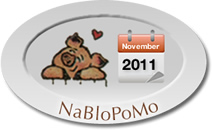
{{there's only 7 days left of Nablopomo 2011!!}}
August 30th, 2011
| 10 Comments »
Knife skills. It doesn’t just mean that you can hold a knife and cut an onion. It has nothing to do with being able to avoid cutting yourself. And it isn’t even about knowing the difference between chopped, diced and minced. (but do you know the difference??)
Knife skills are necessary in the culinary world. The proper grip, the best balance aside, knowing how to julienne, chiffonade and batonnet, make a brunoise and a tourné potato are de rigueur. We spent hours in culinary school, hunched over cutting boards of vegetables, practicing our cuts until our hands were cramped and sore. We hissed streams of profanity sometimes at our inability to get it right, and many poorly constructed cuts were lobbed across the kitchen in frustration. We are, after all, a profession of avowed perfectionists. Knife cuts, and making them the right way is a big deal, as they are a requirement in many, many professional kitchens.
In addition to the requirements of our classes, I participated in a student culinary competition where part of our score was judged on a variety of knife skills. We practiced these skills for months, creating mountains of carrot batons in perfect symmetry, perfect little tournés of potato like tiny white footballs and enormous amounts of parsley, chopped to the consistency of sand. I never once expected they would ever benefit me until I spent a summer in the kitchen of an upscale golf club where my ability with a knife was held in high esteem. It may seem strange to always make my diced onions perfect when all they’re going in to is a soup, or to slice those carrots in perfect coins, the garlic to micro-thin slices, but this is what I know, and what I was trained to do. It doesn’t matter that it now only benefits my family (and readers of this blog). It’s a skill I’ll never unlearn, no matter what.
And it came in very handy when creating this Kale Slaw.
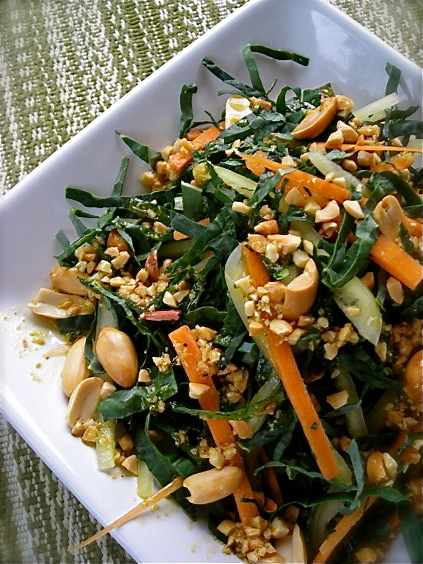
And this slaw was only for my eyes, really. I wasn’t making it for a magazine shoot, a fancy dinner or company at my house. But in creating something lovely, just for myself, I am raising the bar on my meals from a routine and mundane thing to a meal wtih some elegance. It didn’t have to be this good. I didn’t have to hone my chef’s knife before taking on the kale. I didn’t need to carefully slice the carrot and pepper. It didn’t have to be perfect.
But piled on a plate and dotted with crushed and whole peanuts, this Kale slaw, with it’s peanut dressing, was a thing of beauty. The dark rich green of the kale, the sharp orange carrot and pale white heirloom pepper, all snapped out from under the blade of my knife without much thought. And that’s part of the appeal. This wasn’t any special consideration. It just happens like this in my kitchen as a matter of fact. I’ve got amazing knife skills, and it isn’t something to hide, really. It’s something to share, to rejoice about and to say ‘Hey, look at that. Isn’t it pretty?’ Because it is. And it was worth all the pain in my hands, the stiff fingers and the endless amounts of hours put in to make it that way. It raises the bar on a simple meal, eaten at my patio table with a pretty basic glass of wine. It makes a Saturday evening alone just that much more fun and exciting.

Those of you who know me outside of this site know I am not very boastful. I’m not one to accept praise all that often, but you put a knife in my hands and I’m going to show you what I can do because this is a skill I am proud of, and one that didn’t come easily. I have pretty severe repetitive stress injuries in both my wrists, and learning to do this in school was torturous and sometimes left me in tears, with my pained hands resting in ice water to reduce the inflammation. My work at the golf club was often hampered by this affliction, but to hear the chef comment on how nice my vegetable trays looked made the discomfort worthwhile, even as I bit back the pain and went home to ice baths and Advil.
I love the earthy crunch to this slaw and the nutty flavor of the dressing. The kale isn’t cooked, but the dressing soaks in to it and softens the texture nicely. I used lacinato kale and loved the dark color against the carrot and pepper. I think some red cabbage in this would be very pretty too, or the lighter frilly green of Savoy. If you don’t care for peanuts or can’t have them, try using almonds, or pecans. One nice aspect of this recipe, and using raw kale is that even the next day there’s no soggy leaves. The sturdy kale can withstand an overnight, bathed in this nice dressing and still maintain good crunch for lunch on the second day. The overall flavor of the salad was richer, and more pronounced too.
Kale Slaw with Peanut Dressing
2 large bunches of kale, either lacinato or curly, washed and spun dry
2 medium red pepper, sliced very thin
2 carrots, peeled and sliced lengthwise
1 c. roasted peanuts
1/4 c. olive oil
2 T. apple cider vinegar
1 T. packed brown sugar
1/4 t. sea salt
Pinch of red pepper flakes
Fold kale leaves in half and tear out tough stems. Roll leaves tightly and slice thinly into very fine ribbons. Toss kale in a bowl with the pepper, carrot and half a cup of whole peanuts.
In a measuring cup, whisk the oil, vinegar, sugar, salt and pepper flakes. Using a food chopper or small food processor, chop the remaining half cup of peanuts into mostly fine pieces. Remove from chopper and add 2-3 tablespoons of them to the dressing, and whisk to mix. Pour dressing over kale, toss to coat and allow to sit for 10-15 minutes. Toss again and serve, sprinkled with remaining crushed peanuts.
August 20th, 2011
| 2 Comments »
What’s that saying? ‘Necessity is the mother of invention?’
Many amazing recipes occur when the frantic need for something to add to dinner comes up and I wildly glance in the pantry to see what I’ve got. What odds and ends are laying about in the fridge? What needs to get used up? What tastes good together?
I fling a lot of ingredients in a pan, or a bowl and I cross my fingers a lot when I cook. Whether it’s out of ‘necessity’ like the quote, or just curiosity, it’s not often that I follow a recipe. More likely, I am making something up as I go. Thankfully, more often than not the results are pretty tasty.
The worst part of it all is that if I don’t write down what I did, I rarely remember it to be able to recreate the dish.
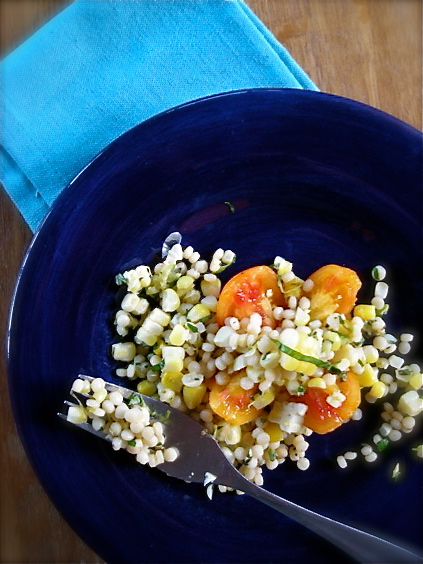
This one, however, did not get away from me.
Side dishes have always been a favorite of mine, and lately I’ve been on this kick of filling my plate with nothing but ‘side’ dishes. The nice thing about removing the focus of meat from our meals is that just about everything we do now can either be termed a ‘main’ dish, or a ‘side’ dish. And sometimes, all of what is being served at our table, technically, are sides.
Griffin was making fish for dinner recently (yes, we eat fish) and we both really wanted something unique on the side. I keep a lot of rice and grains handy, but we were short on time and didn’t want to wait for brown rice, or wild rice to cook. He was digging through our pantry and pulled out a jar of pearl couscous, asking me ‘What’s this?’ And as with necessity, and invention was born.
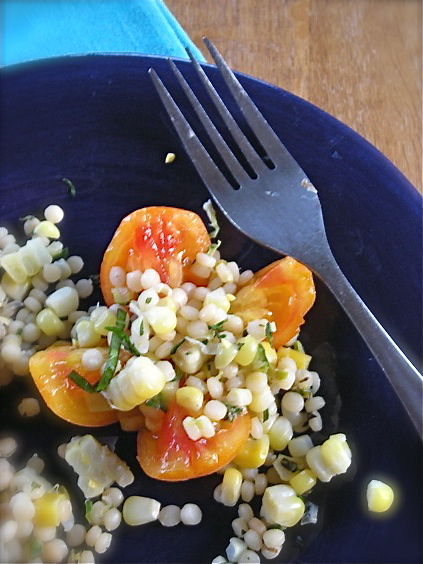
Pearl couscous, mostly recognized as Israeli couscous, is the thicker version of the tiny semolina grains that most people know best. Couscous isn’t really a ‘grain’ like farro, or quinoa; it’s pasta in minutiae form. The instant version of couscous cooks in a flash by adding the tiny beads to boiling broth. The larger form takes a bit longer, but still is quick enough to make for an easy dinner. We used chicken broth, some frozen corn and a generous handful of fresh herbs from the garden and the result was surprising to all of us. It’s light and flavorful and wondrously versatile, but not heavy like larger pasta shapes. I think some form of this will be making regular appearances on our dinner table. With enough fresh vegetables added to it, the dish becomes a meal in itself, or you can serve it over a garden fresh tomato for a perfect salad option. It actually tastes wonderful cold too.
Did you notice the new print button feature??? Pretty cool, huh??
Pearl Couscous Pilaf
1 c. pearl couscous
1-1/4 c. well seasoned broth (can use vegetable, mushroom, chicken….)
1 medium leek, or 2 small ones, sliced and washed well (can sub a finely diced onion)
2 cloves garlic, crushed
1/2 c. vegetable of choice (we used corn; try diced zucchini or other fresh seasonal vegetables)
1/4 c. fresh herbs, finely chopped (we used thyme, oregano and basil, then parsley to finish)
In a deep skillet with a cover, heat a few tablespoons of oil. Add the leek and cook, stirring regularly, until softened and beginning to brown in some places. Add in the garlic and cook, stirring for about a minute. Add the corn (or whatever vegetable you are using) and stir to coat with the oil mixture, then add the couscous and cook, stirring, for about 5 minutes. Pour in the broth, stir to combine and bring to a boil. Then reduce the heat so it simmers, cover the pan and allow to cook, undisturbed, until the couscous absorbs all the broth. It should take about 10 minutes. Allow it to sit for about 5 more minutes, off heat. Before serving, toss the fresh herbs in and stir to combine, seasoning with salt and fresh pepper. Top with parsley as a garnish.
August 15th, 2011
| 3 Comments »
Not even five minutes into my Sunday morning hike and already my shoes are soaked from the dew. I have to make a split second decision as I feel cool, wet water seeping through my socks; turn back or keep going. There might be blisters at the end, surely some chafing from my hiking shoes, but it’s a glorious August morning and the sun is glaring down on me. I can’t go back. Ignoring my wet feet, I move on.
I’m in Otter Lake Regional Park and this is my glory place, my church of the great outdoors. Plopped in the middle of White Bear Township, it’s a tiny little park, with a very nice nature center and hiking trails that make you feel like you’re miles from the outer world. It’s where I cross country ski in the winter time, and for the other three seasons, I roam it’s trails and discover more and more every day to love about it. On this particularly beautiful morning, in the high season of summer, I take to the trails, dew and all to seek out something I can’t find among the concrete.
My favorite path is cut short by standing water; it’s unusually low in that area, and during the Spring thaw, the trail is often impassable, but it always dries out. But this summer, with it’s abundant rainfall, it’s a no-mans land. I keep on the path that leads me around the back of the newly constructed natural classroom and head in to the swamp. This trail will lead me to the northwest section of the park where the hardest challenge of my hike lies. In there, the path cuts through a sanctuary of birch and towering oak trees, dipping down sharply, then rising just as fast to offer a heart-pounding, blood racing interval that I love. I can’t even consider going on this trail in the wintertime, on my skis. It’s challenging enough on foot, but I can’t stay away. The majestic oak trees line the path, like sentries that silently watch me pass, breathing deep, as the smaller of the two lakes in the park wink it’s shimmer of blue through the tree line. I try to challenge myself to run hard up a few of these short but steep hills. I’m ignoring my damp shoes.


Coming out on the other end, I’ve broken a sweat and wish I had my water bottle. The sun has rose high enough now to pound on my skin, and the wind swirls around me. It’s not strong enough to keep the flies at bay, and I impatiently swat away at them, mentally reminding myself to bring bug spray the next time I come here. This section of the path, through the heart of the park is high and open. No trees hide the sun out here and as I push on, beads of sweat slip down my temples.
The best part of being out here isn’t the nature. It isn’t hearing the hum of the highway along the western edge of the park, or the sound of the trains in the distance, blasting their whistles as they through the crossing. It isn’t the flash of deer, startled from their morning graze, leaping through the trees with white tails whipping, nor the fox, visible only by it’s bright red bushy tail twisting as it runs. It isn’t the small brown snake that lifts it’s head as I approach, watching me closely. “I’m no threat.” I murmur, slowing down to gaze at it’s tiny eyes. It doesn’t even flinch as I carefully step over it, and turning back as I move on, I see it’s watching me.
It isn’t any of these things, nor the rustle of the grass, or the continual droning hum of the insects. It isn’t the fluttering butterflies that skip along the path ahead of me, all shapes, sizes and colors. It’s isn’t any of it, and it’s all of it. Because out here, with the open skies and clean air, coupled with my footsteps and steady, hard breathing, it’s all of it at once that tames the voices inside, the swirl of life in my head that becomes a cadence of regular disruption. I come out here and it all disappears. My head clears, while the constant motion in it stops and I can breathe, relax, feel my blood pound and just let go. I am in sync with myself on this path, instead of at war with trying to figure out what’s next.
Then the trail dips down to the larger lake, and winds around to the north. It’s really uneven here, and now I am fully aware of my hiking shoe rubbing on my right ankle. The arthritis in my feet is apparent, but it will never stop me; it’s just more noticeable where the path is the least stable. The grass is tall and it tickles my legs. I swat the flies, wipe the sweat and keep going because soon, there will be the boardwalk leading me around the side of the lake, and at the other end is the thickest, densest trees and a hard packed dirt path that will take me back to the place I began. I’m on the last leg and those woods, with the tall maples and cool shadows will feel really, really good after the heat and sunshine. I feel the temperature drop as I enter here, and the slight chill rejuvenates me. Sunlight is dripping through the high tree canopy. And it’s glorious with bird song.

But the mosquitos in here are terrible. I can’t stop, or even slow down. I want to grab a few photographs to chronicle this morning, but I am swarmed with nibblers if I try to catch my breath. My feet feel better, but the rubbing on my ankle is a chronic annoyance. Because it’s cool in here though, the sweat slows down and I don’t have to wipe my face so much. My heart and lungs are on full power now; I’ve been hiking hard for 45 minutes by the time this trail leads me back out to the blacktop path that I started on. The nature center is in sight, and the parking lot, where my car and my water bottle await, is beyond that. My head feels soothed and I take a deep breath, once again. I’m back to the car, stripping off my soaking wet shoes and socks, wiping down my feet with the wipes I keep in my car and toweling off the sweat. My water bottle is half empty already. I stretch out the tension, drop in to a few yoga positions to re-focus and eventually climb in to my car to head home. In less than an hour I hiked nearly 4 miles.

And I’m so hungry now.
At home is waiting the simplest of simple summer salads, perfect for these heady days of heat and sun. The farmers markets are absolutely bursting with a mind-boggling bounty of fresh food and I am crazy in love with sweet corn, fresh tomato, zucchini for the grill, tiny purple eggplants and dark, dark greens. Every meal tastes like sunshine, each bite bursts with flavor. I snip handfuls of herbs from the garden to crush and sprinkle over everything and even after washing my hands I can still smell the thyme, the parsley and basil, the volunteer oregano that sprung up from last years plants.
 
And this salad…. this salad awaits my gnawing stomach, the hunger driven out of a vigorous hike, deep gulps of clean morning air and the need to still my mind. It’s simple, quick and so delightful; the snap of fresh tomato, fresh zucchini chunks, crunchy corn kernels that still taste like a farm field and lots and lots of tiny thyme leaves. A few scattered pieces of lemony goat cheese makes it complete.
My shoes are drying in the hot sun, outside on the patio and I need a shower. My ankle didn’t blister, thank goodness, and while my body is energized from it’s workout, my mind is at rest. This is a good place to be. Like August, with it’s wellspring of fresh vegetables.
What’s on your summer table these days??
(Notice anything new down below here?? There’s a print button for my recipes now!!)
Herbed Sweet Corn and Tomato Salad
4 ears sweet corn, shucked, cooked and stripped of kernels
4 medium tomatoes, or 1 pint fresh cherry tomatoes, as ripe as you can find
2 small zucchini, diced
1/2 c. fresh chopped herbs, such as basil, thyme, parsley and oregano (use rosemary if you like it)
2 T. good quality olive oil
Fresh ground black pepper and sea salt
Combine all ingredients in a medium bowl and drizzle with olive oil. Season to taste with salt and pepper. Allow to stand for 5-10 minutes to combine flavors. Serve topped with goat cheese, if desired.
My Notes: I used half a pint of purple cherry tomato, and one good sized orange heirloom tomato for my version of this dish. I also diced up a fresh heirloom pepper that I had on hand. I think one of the best parts about this dish is how colorful it can be with the variations available now. As the salad stands, it will release plentiful juices which are delicious if you dip fresh toasted bread into them, then sprinkle a bit of sea salt over before eating.
June 27th, 2011
| 6 Comments »
I stopped eating meat with every meal on May 2. And I love how I feel nowadays, but I didn’t expect that I’d enter in to a time of total culinary paralysis when faced with re-working a lifelong habit of making meat the center of my meals.
We haven’t wasted away, thank goodness, and we never will. We’ve made some delicious foods but I haven’t stretched myself a whole lot. I’m grilling a lot of veggies, sticking them on amazing breads or tying them up in delicious pilafs. I made this fragrant and savory Red Lentil Dhal that we’ve loved since the first time it crossed our stove and landed in our bowls. We’ve enjoyed plenty of legumes, super fresh salads topped with a wide array of ingredients and terrific grilled cheese sandwiches. But I’m not content to play it safe, to stick with what I know will be wonderful. I want to expand, to grow and to embrace fully this new method of eating and not just end up a Junk Food Vegetarian.
So I’m scouring the ‘net for inspiration, grabbing books with gusto from library shelves, from Half Price Books and from friends hands (not really, but I would if the opportunity came up) just to get my mind rolling into this new territory. And it is new territory. It’s a new and totally different way of life and even being as good a cook as I am, I’ve had moments of sheer panic in thinking ‘What the hell do I make now?’, hence the aforementioned grilled cheese.
The worst part was finding the time. I had to stop over-scheduling all my time away from work into activities that were taking me away from home, away from time to experiment and work up some of these new options. I think, subconsciously, I was avoiding it. No more. It’s time to start applying tabs to the cookbook pages, plot out a few weeks worth of meals and get back on track. The nicest part of being meat-free is how much it frees up in our budget. I knew we spent a lot on meat, but folks, it’s outrageous what we have to work with now that this aspect of our eating is gone.
So I started with chickpeas. But not just any chickpeas. This is a kick in the mouth, heady and WOW recipe that will just plain knock you on your tush.

And they look so innocent, don’t they?!
We do love our chickpeas around here, and Mike has taken to making some pretty tasty hummus for us to snack on. Then I discovered Roasted Chickpeas and my life suddenly seemed more complete. But really, that was just the tip of the iceberg because I found a recipe for this Indian Spiced Chickpea salad and now I’ve got something going with this handy and nutritious little legume. It’s called love. Luuuuurrrrrve, people. Straight up legume love.
With no cholesterol, no sodium, no saturated fat; an excellent source of protein and fiber, as well as minerals like folate, calcium, magnesium and potassium, it’s a super-duper powerhouse for the meatless maniac such as myself. And when paired with toasted mustard, fennel and cumin seeds with a nice shake of crushed red pepper, plus smooth creamy greek yogurt to soften the flavorful blow to your tongue, it a cool little force to be reckoned with. Like my resolve. This is just a few steps for me, this quick jaunt out of the starting gate. The gun has sounded. And there’s a lot of road to cover up ahead so hang on, all right? Here we go.
Note: This recipe is ridiculously simple to make, but the flavor improves over time as it sits. Make it up and allow an hour, or even more if you can, for sitting, stirring regularly. If you like less of a crunchy seed factor, grind the fennel and cumin seed before adding it to the oil. You’ll still get a load of flavor without the crunch. Don’t grind the mustard seeds. Those soften really well.
Indian Spiced Chickpeas
Two 15-ounce cans chickpeas—rinsed, drained and patted dry
2 tablespoons peanut oil
1 teaspoon mustard seeds
3/4 teaspoon cumin seeds
3/4 teaspoon fennel seeds
1/4 teaspoon crushed red pepper
3/4 cup plain whole-milk yogurt
1 1/2 tablespoons fresh lemon juice
2 scallions, thinly sliced
1/4 cup chopped cilantro
1/4 cup chopped mint
1 teaspoon kosher salt
Pour the chickpeas into a large bowl. In a small skillet, heat the peanut oil until shimmering. Add the mustard seeds, partially cover the skillet and cook over moderately high heat until the mustard seeds stop popping, about 1 minute. Add the cumin and fennel seeds and the crushed red pepper and cook until the mixture is fragrant, about 30 seconds. Pour the hot oil and spices over the chickpeas. Stir in the yogurt, lemon juice, sliced scallions, chopped cilantro and mint and salt. Serve the chickpea salad at room temperature.
Recipe Credit: Food and Wine magazine
May 13th, 2011
| 2 Comments »
Summer tomato season is heading our way. I don’t have a huge garden plot to grow produce in, but I always grow tomatoes as there is nothing finer on this earth than a homegrown organic tomato. Come August, we’re usually over-run with them, and are eating them in everything. And really, there’s nothing better than a fruit so delicious that you can slice it, grate a bit of fresh black pepper on it and eat it with a fork.
This year, we’ll be utilizing a lot more tomatoes in this delicious and simple Shrimp Panzanella Salad I’ve discovered
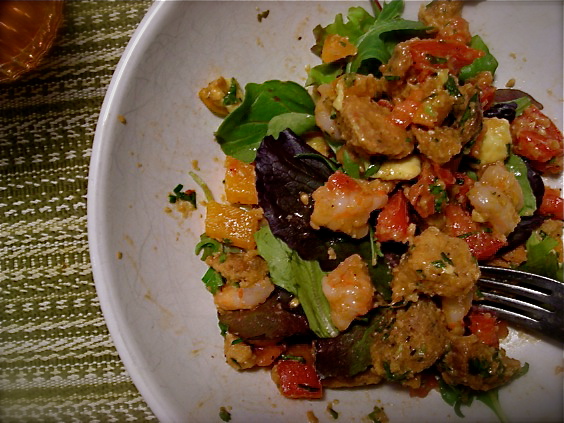
As luck would have it the night I made this, a gorgeous sunny day had turned dark and cloudy, with storms brewing, so this photo is nowhere near as bright and summery as this salad’s true appeal. Fresh chopped tomato and peppers, doused with a liberal amount of oil, a splash of good vinegar and a veritable shower of fresh parsley, basil and thyme and the taste that springs from your fork is all about Summer! Summer! Summer! Even when Spring! struggles to fully arrive here in Minnesota.
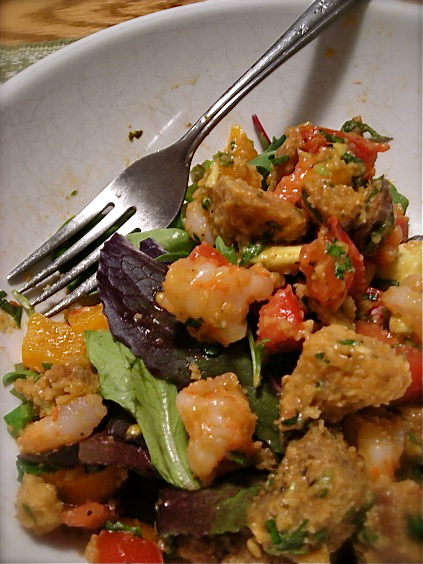
So imagine it yourself; the taste of a ripe juicy tomato, the crunch of seasoned and browned cubes of hearty bread, toasted to a firm crunch, the snap of bell pepper and the heady flavor of fresh herbs. Mix in pieces of perfectly cooked shrimp, doused with a bit of chili garlic sauce for spice, served over fresh spring greens and you’ve got a dinner salad with substance, not to mention a wild ride of textures, flavors and colors. I could have admired it in my bowl if I wasn’t so hungry.
And simple? This here’s an easy, quick dinner to have ready. With a few shortcuts like artisan croutons and cooked shrimp, you can get this together in about 15 minutes, yet it’s hearty enough to fill you up, but not leave you sluggish. It may even give you an extra burst of energy to head out after dinner for a gorgeous sunset walk.
Shrimp Panzanella Salad
4 c. multi-grain bread cubes, preferably day old. Or equivalent of pre-made croutons.
1# coarsely chopped cooked shrimp
4 large ripe but firm tomatoes
2 bell peppers, any color, chopped
3/4 c. fresh chopped parsley
1/4 c. fresh chopped basil
3 T. fresh thyme
1/4 c. pitted kalamata olives, plus 2-3 T. brine
3 T. red wine vinegar
1-1/2 t. fresh chopped chives
Spring greens of choice
Fresh ground black pepper and sea salt
If using fresh bread cubes, preheat oven to 350°. Place bread cubes in a large bowl and drizzle with 2-4 T. olive oil. Toss to coat and spread on a baking sheet. Bake the cubes, stirring every 5 minutes or so until they’re very crisp and dried, about 15-20 minutes. Watch them carefully. Allow them to cool completely before assembling the salad.
Combine the shrimp, tomato, bell pepper, fresh herbs, olives, brine and vinegar in a large bowl. Drizzle with 3-4 T. olive oil and toss to coat. Add cooled bread cubes, toss to combine. Season to taste with salt and pepper. Allow to sit for 15 minutes to mix flavors.
Serve over spring greens.
Adapted from Eating Well magazine.
|

























